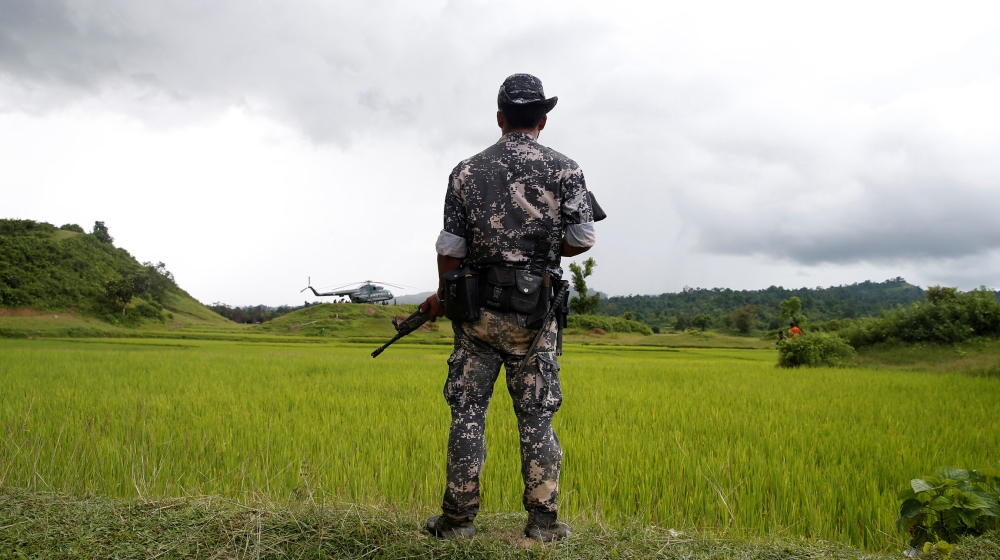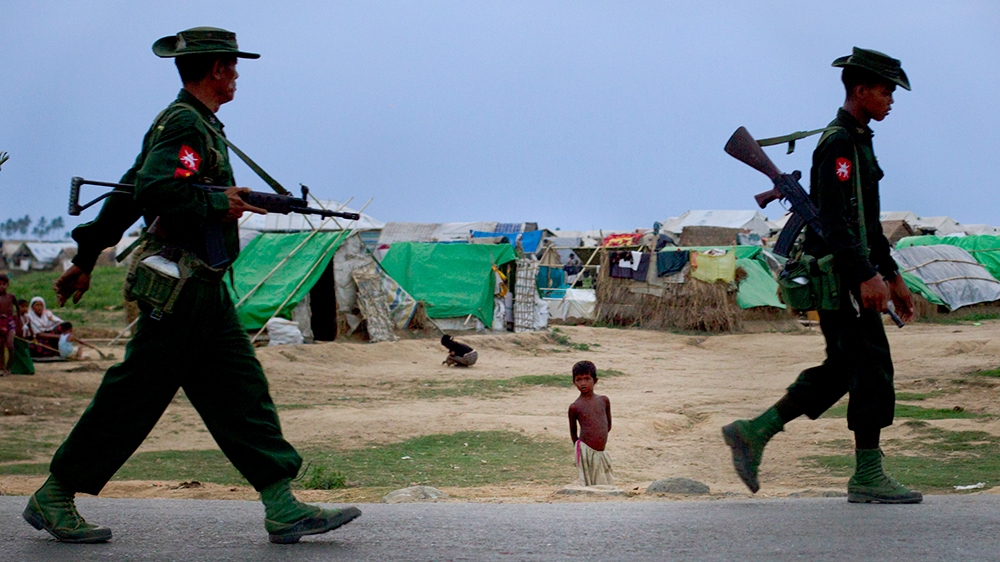Myanmar army probes ‘wider patterns’ of abuse against Rohingya
The military acknowledged for the first time a possible ‘pattern of violations’ before and during the 2017 crackdown.

The Myanmar military has said it is investigating “possible wider patterns of violations” before and during a 2017 crackdown in Rakhine state that the United Nations has said was executed with genocidal intent against Rohingya Muslims.
More than 730,000 Rohingya fled to neighbouring Bangladesh that year following the launch of a sweeping security campaign that refugees said included mass killing, gang rape and arson.
Keep reading
list of 4 itemsConflict, climate, corruption drive Southeast Asia people trafficking: UN
Bodies of three Rohingya found as Indonesia ends rescue for capsized boat
How is renewed violence in Myanmar affecting the Rohingya?
The army has denied genocide, saying it was carrying out a legitimate operation against Rohingya rebels, but says it has court-martialled some troops over incidents in certain villages, though details on the perpetrators, their crimes, and sentences have not been released.
The military, in a statement carried in state media on Tuesday, acknowledged for the first time a possible broader pattern of abuses.
It said the military-run Office of the Judge Advocate General had reviewed a report by a government-backed commission that accused soldiers of committing war crimes and had expanded the scope of its investigations in response.
The office was “investigating possible wider patterns of violations in the region of northern Rakhine in 2016-2017”, the military said in the statement.

“Allegations regarding villages in the Maungdaw area are included in the scope of this wider investigation,” the military said, referring to a district on the border with Bangladesh that was a focus of its security operations in 2017.
It provided no more details and an army spokesman did not answer telephone calls by Reuters seeking further comment.
The announcement follows reports last week that two Myanmar soldiers have been taken to The Hague to appear as witnesses or face trial after confessing to killing dozens of villagers in the north of Rakhine state and burying them in mass graves.
On Monday UN High Commissioner for Human Rights Michelle Bachelet demanded action to remedy the serious rights violations suffered by Rohingya minority.
Rohingya villages erased from map
It comes less than a week after the United Nations said that Myanmar erased the name of Rohingya village of Kan Kya from official maps. The military had burned the Rohingya village to the ground and bulldozed over its remains three years ago following its brutal campaign against the Muslim minority.
Their intention is that we do not return.
About three miles (five km) from the Naf River that marks the border between Myanmar’s Rakhine state and Bangladesh, Kan Kya was home to hundreds of people before the army drove out hundreds of thousands of Rohingya out of the country in what the UN described as “a textbook example of ethnic cleansing”.
Where Kan Kya once stood, there are now dozens of government and military buildings including a sprawling, fenced-off police base, according to satellite images publicly available on Google Earth and historical images provided to Reuters by Planet Labs. The village, in a remote region in the northwest of the country closed off to foreigners, was too small to be named on Google Maps.
On maps produced in 2020 by the United Nations mapping unit in Myanmar, which it says are based on Myanmar government maps, the site of the destroyed village is now nameless and reclassified as part of nearby town Maungdaw. The unit makes maps for the use of UN bodies, such as refugee agency UNHCR, and humanitarian groups that work with the UN in the field.
Kan Kya was one of almost 400 villages destroyed by the Myanmar military in 2017, according to satellite images analysed by New York-based Human Rights Watch. And it is one of at least a dozen villages whose names have been erased.

“Their intention is that we do not return,” said religious leader Mohammed Rofiq, a former chairman of a village close to Kan Kya who now lives in a refugee camp in Bangladesh, referring to the Myanmar government.
The social welfare ministry, which oversees Myanmar’s rebuilding activities in Rakhine state, declined to answer questions from Reuters about the erasure of village names or the government’s policy concerning the return of Rohingya refugees. The ministry referred questions to the General Administration Department (GAD), which did not respond.
A representative of the Myanmar government, led by State Counsellor Aung San Suu Kyi, also did not respond to a request for comment.
‘Exterminating their basic identity’
The UN’s map department has produced at least three maps since the start of the year that show several Rohingya village names have disappeared or been reclassified by Myanmar.
The UN said it removed some maps of Rakhine state from its website in June and started a study to assess the effects of the government’s policies on villagers and returning refugees after the Arakan Rohingya National Organisation, a UK-based Rohingya rights group, complained to the UN about the removal of village names.
The UN said the study has not reached any conclusion.
Yanghee Lee, a former UN human rights envoy to Myanmar, said the government was purposefully making it hard for refugees to return to places with no name and no evidence that they ever lived there. “This is a way of exterminating their basic identity,” she said.
Lee said the UN was complicit in allowing that to happen by not challenging the Myanmar government: “There hasn’t been any leadership that will say, ‘Wait a minute, the buck stops here, we’re not going to let this continue.'”
Several UN officials interviewed by Reuters declined to directly address why the UN had raised no objections or tried to stop it.
Ola Almgren, head of the UN mission to Myanmar, said he had not raised the issue of erasing village names with the Myanmar government, but said he had urged the Myanmar government to create “conditions conducive” to the return of refugees.
Stephane Dujarric, the spokesman for the UN Secretary-General Antonio Guterres, said the reclassification of some villages as wards was a “routine administrative procedure”. The UN mapping unit “utilises the official government names of places so as to avoid confusion among aid workers and government officials in the field,” he said. “The standing UN practice worldwide is to employ officially designated place names for all publicly distributed maps and products.”
Dujarric said that changing the legal status of villages may become “an additional layer of complexity” in refugees reclaiming their former homes, without providing specifics.